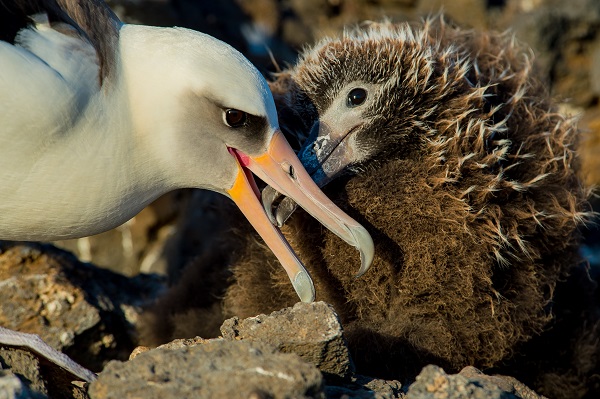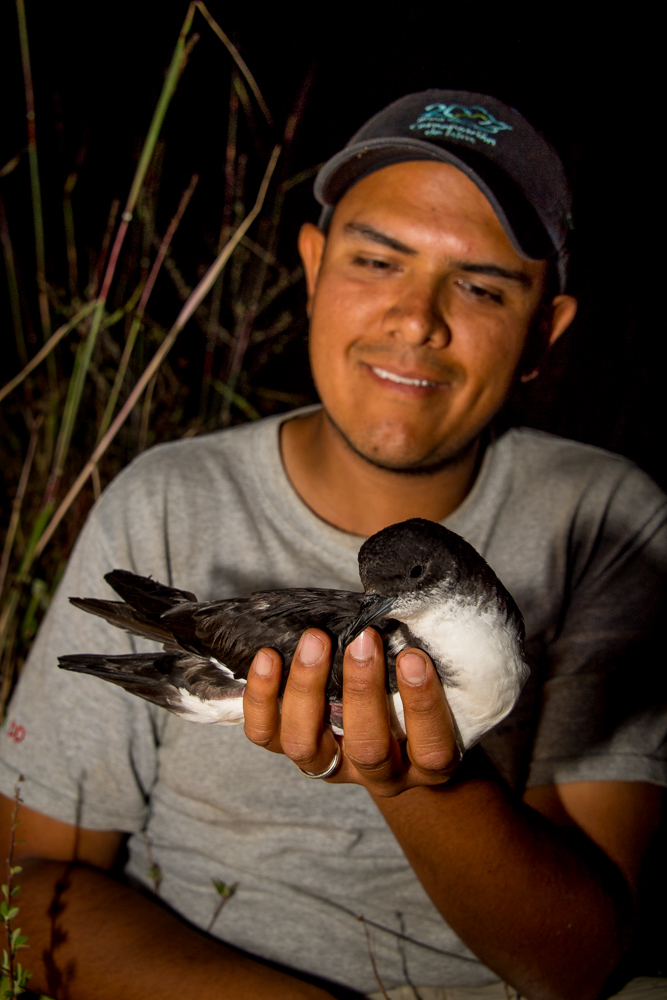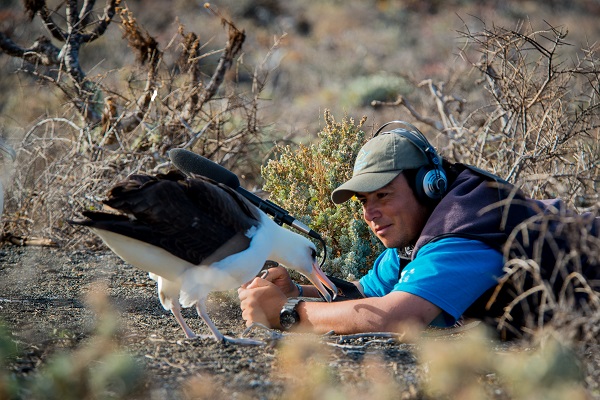
A Laysan Albatross feeds its chick on Mexico's Guadalupe Island, photograph by J.A. Soriano, GECI
The Grupo de Ecología y Conservación de Islas, A.C. (GECI) is a Mexican environmental civil society organization whose mission is the comprehensive restoration of the islands of Mexico and the conservation of their species. Since its founding in 1998, in strong partnership with the Mexican Government, in particular with the Ministry of Environment and Natural Resources (SEMARNAT), the National Commission for Natural Protected Areas (CONANP), the National Commission for the Knowledge and Use of Biodiversity (CONABIO), and the Secretariat of the Navy (SEMAR), GECI has worked towards reducing threats facing the country’s islands by eradicating introduced species on them. A few of Mexico’s offshore and remote islands, Guadalupe, Alijos, Clarión and San Benedicto - all Protected Areas under management by CONANP - support mainly small breeding populations of Near Threatened Laysan Albatrosses Phoebastria immutabilis – the most easterly of the species’ wide distribution in the North Pacific.

ACAP Latest News got in touch recently with GECI’s Executive Director, Federico Méndez-Sánchez, who quickly replied, expressing enthusiastic support for the inaugural World Albatross Day on 19 June this year. At ALN’s request Federico and two of his senior colleagues have written, fittingly in both English and Spanish, describing some of their conservation work on their albatross islands.

Federico explains: “For over 20 years, Mexico has undertaken significant actions to protect and conserve the Laysan Albatross. Keeping its breeding colonies in Mexico free from island pests has been one of the most relevant conservation actions. Particularly, great efforts have been made on Guadalupe Island to eliminate predation by feral cats on Laysan Albatrosses. In 2003, we started cat control around breeding colonies; in 2014 we installed a cat-exclusion fence in the southern part of the island, thus liberating 62 hectares from the threat. Finally, in 2017 we began with an island-wide cat eradication campaign, aiming to have a cat-free Guadalupe Island by 2021. Thanks to these conservation actions, the Laysan Albatross population on Guadalupe Island is growing and considating as the most important breeding colony for the species in the eastern Pacific.”
“Por más de 20 años, México ha realizado importantes acciones para proteger y conservar al albatros de Laysan, siendo una acción muy relevante el mantener libres de especies exóticas invasoras las colonias reproductivas de esta especie. En particular, en Isla Guadalupe se han realizado grandes esfuerzos para eliminar la depredación del gato feral sobre el albatros: en el año 2003 se inició el control poblacional de gato feral alrededor de las colonias reproductivas de albatros; en el 2014 se instaló un cerco de exclusión de gatos en la parte sur de la isla, generando 62 hectáreas libres de esta amenaza; en 2017 inició la erradicación de gatos en toda la isla, misma que culminará en 2021. Gracias a estas acciones de conservación, la población de albatros de Laysan en Isla Guadalupe está creciendo y consolidándose como la colonia reproductiva más importante de pacífico oriental”.
Federico’s colleague, Yuliana Bedolla-Guzmán, is the group’s Marine Birds Project Director. She writes: “Guadalupe Island has become the main breeding site for the Laysan Albatross in the eastern Pacific. Its population has steadily increased since its first record in 1983. Nowadays, there are over 1400 breeding pairs nesting on Guadalupe and two of its islets: Morro Prieto and Zapato. Here, its breeding success is one of the highest recorded globally for the species (74-83%). Guadalupe Island has its own peculiarities as a breeding site: its height and temperate climate; its proximity to nutrient-rich productive zones, such as the California Current where the albatrosses feed during the breeding season; and less plastic pollution. These characteristics make Guadalupe Island an ideal home for the Laysan Albatross to support the conservation of the species at a global scale”.

“Isla Guadalupe se ha convertido en el principal sitio de anidación del albatros de Laysan en el pacífico oriental. Su población ha estado en constante crecimiento desde su primer registro en 1983. Actualmente, la población es de más de 1,400 parejas reproductivas entre Isla Guadalupe y sus islotes Morro Prieto y Zapato. Aquí, su éxito reproductivo es de los más altos registrados para esta especie a nivel mundial (74-83%). Isla Guadalupe presenta particularidades únicas como colonia de anidación: su imponente altura y clima templado; la cercanía a zonas de alta productividad oceánica como la corriente de california, en donde se alimentan en temporada reproductiva; y menor contaminación de plásticos en el mar. Todas estas características hacen que Isla Guadalupe sea el hogar ideal de los albatros y una alternativa para la conservación de esta especie a nivel mundial”.
Julio Hernández-Montoya, GECI’s Guadalupe Island Project Director, has his say: “Congratulations to albatrosses on their day! It is a special day for everyone who has ever had the opportunity to interact with these marvellous birds. For the last 13 years, I have had the pleasure to admire their extraordinary fortitude, dedication to their nest, commitment to their partner, tender care for their chicks, spirit of freedom and courage during their feeding trips, great lessons of survival to allow chicks to fledge from their nests, and an astonishing love for their birthplace. These traits never cease to amaze me and have shaped the way I see the world. It is a commitment for me and my colleagues in Mexico to continue working to conserve these majestic birds so that they continue to fill the skies of the world with inspiration, wonder and beauty”.

“¡Muchas felicidades a los albatros en su día! Es un día especial para todas las personas que hemos tenido la oportunidad de conocer e interactuar con estas maravillosas aves. Durante estos últimos 13 años, he tenido la dicha de admirar su inagotable nobleza, extraordinaria fortaleza, dedicación al nido, compromiso con su pareja, tiernos y sutiles cuidados a las crías, incansable espíritu de libertad, valentía y arrojo en sus viajes de alimentación, grandes lecciones de sobrevivencia para que los pollos abandonen el nido, y un asombroso apego al lugar donde nacen. Todas estas características no dejan de asombrarme año tras año y han formado parte de mi manera de ver el mundo. Es un compromiso para mí y mis colegas en México, el continuar conservando estas majestuosas aves para que sigan llenando de inspiración, asombro y belleza los cielos del mundo.”
Federico holds a Townsend's Shearwater Puffinus auricularis on Socorro Island, Yuliana is holding a Black-vented Shearwater P. opisthomelas on San Benito Oeste Island, and Julio is recording calls from an inquisitive Laysan Alabatross on Zapato Islet, next to Guadalupe Island.
Although Mexico is a breeding range state for an ACAP-listed species, it is not a Party to the Agreement. However, delegates from Mexico have attended and contributed to past ACAP meetings as observers and contacts are maintained between the ACAP Secretariat and Mexican officials.
With thanks to Federico Méndez-Sánchez, GECI Executive Director. All photographs by J.A. Soriano, GECI
John Cooper, ACAP Information Officer, 10 February 2020

 English
English  Français
Français  Español
Español